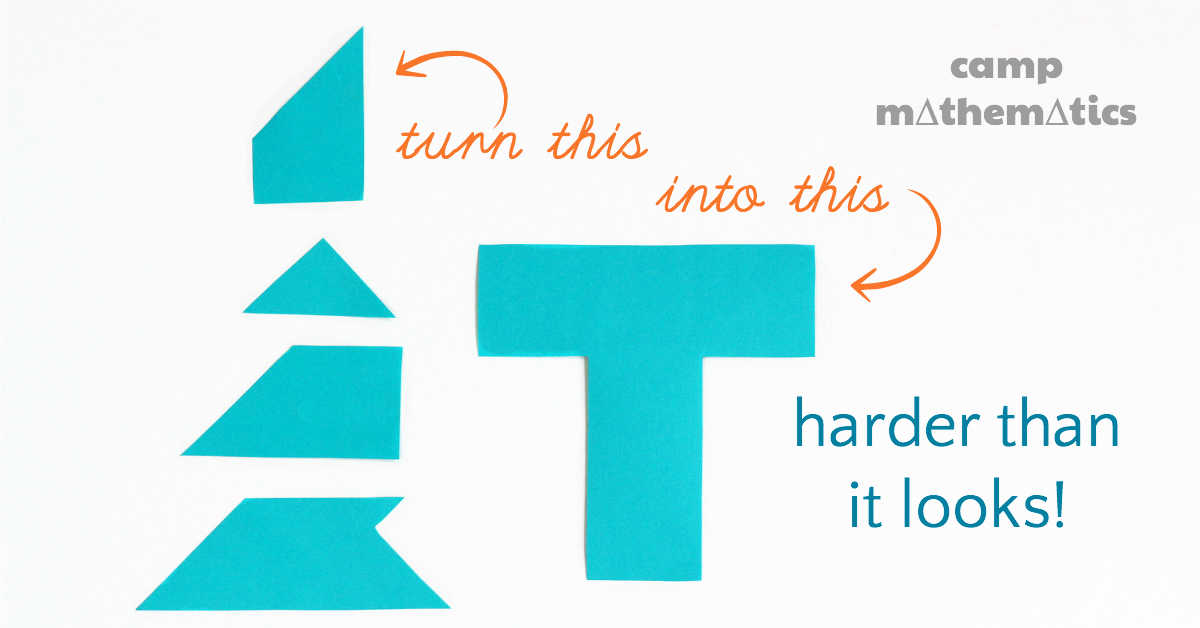When you want to make math fun, ditch the worksheets and drills. Instead, use brain teasers and puzzles like this classic T Puzzle to encourage out of the box thinking. If you are following along with our summer math camp schedule, the T Puzzle is the perfect addition to shapes and geometry week.

What is the T Puzzle?
The T Puzzle is a type of "dissection puzzle". Dissection puzzles are a type of geometry puzzle in which a shape, such as a square or triangle is cut apart. The pieces are then rearranged to make new shapes or put back together into the original shape. Tangrams and the Pythagorean Square Puzzle are the most well known dissection puzzles.
Solving dissection puzzles encourage creative thinking. Often the solution is infuriatingly elusive, even though they look so simple to solve. Kids (and grown-ups!) have to give their spatial thinking skills a real workout.
MORE: 35 DIY Puzzles
How to Solve the T Puzzle
First: Print out our T puzzle template. There are two pages. Cut out the T on the first page and snip it into pieces along the solid lines. (Obviously you want to do the cutting so your kid can't see the solution!)
The second page of the T puzzle printable is for reference, so kids can see what the completed puzzle will look like.
Next: Try to arrange the 4 puzzle pieces into the T shape.
TIPS: There are two ways you can give puzzled kids (pun!) a hint.
- Suggest they complete the puzzle by arranging the individual pieces on top of the colored T on the second page of the printable; or
- Explain no other piece fits into the the notch in the irregular shaped piece.
Why Is the T Puzzle Hard?
As you can see in the video below, the impulse of the puzzler is to "fill the notch". In addition, the large irregular pentagon piece is placed diagonally, instead of vertically or horizontally as one would might assume.
Watch the video!
History of the T Puzzle:
Search for "dissection puzzle" and you will find many different variations. The "T Puzzle" became popular in the early 20th century, although the first mention of it was in the 19th century. Martin Gardner, the man who made mathematics a recreational sport, and whose books I have been exploring said, "I know of no polygon-dissection puzzle with as few pieces that is so intractable."
Extensions:
- Use the pieces to create other shapes. Can you make an arrow? What about another geometric shape like a trapezoid or a parallelogram?
- Cut out the completed T from the second page of our printable, dissect and cut it into different shapes to make your own T puzzle!
- After completing the puzzle, re-scramble the pieces. How easy is it to re-find the solution?
The next theme week of math camp is "patterns and math art," one of my very favorite subjects! But before you go, be sure to hop over to Coffee Cups and Crayons for another geometry math activity (using grapes no less!) to tide you over until next Thursday.
More brain teaser fun: (videos included)




warda says
This looks amazing! Can't wait to try it with my kiddos. Can you please suggest what are the intended age groups this activity can be tried with?
Erica says
I suggest 7 and up.